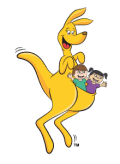Written by Marianne Schriever and Dr Tessa Grigg
Laterality refers to the dominance of one side of the body. Humans are bilateral beings, because we have two sides of the body that need to coordinate with each other so that we can develop good posture, balance, coordination and control. We also need bilateral activities and movements to achieve greater learning.
Laterality describes an important change in your child’s brain where it becomes aware of the two sides of the body and its differences and similarities. The brain starts to recognize that one hand or one foot is better at certain skills than the other. Eventually, we want your child to choose a dominant foot, eye, ear and hand for learning.
The brain is divided into two hemispheres, the right and left, and research shows that young children operate more with the right side of their brain while being creative, using their imagination and thinking generally about something.1 As they grow older, children tend to use the left side of the brain more, as it is used for more complex tasks such as logical thinking, reading and mathematics. When a child is given plenty of opportunities for sensory and motor experiences as a baby and toddler, the brain matures sequentially and their bilateral integration transitions smoothly. When it comes to certain functions and tasks, the child will establish dominance and the brain will start to specialize in one side of the brain.
Bilateral integration develops as babies grow and learn to move their limbs and torsos, develop balance, coordination and posture. As they develop, sometimes the movements are symmetrical, sometimes they occur in opposite directions, and other times they coordinate movements between limbs.
Bilateral integration, which happens sometimes between three and five years of age, creates the opportunity for your child to use both sides of the body in a coordinated manner.1 This includes hands, eyes, arms, legs, feet and the brain. Your child must develop bilateral coordination in all parts of the body to perform gross and fine motor skills and later, logical thinking.
Under the age of three, when dominance is not yet set, children may constantly cross over the midline to reach an object. They will use their right hand on the left side of the body and vice versa. This means they are exercising those neural pathways in the brain, setting up the body and brain for excelling in motor skills and higher learning. This is a sign they are developing their bilateral co-ordination. It means the two sides of the brain are communicating with each other, which is how a child will eventually learn their colours, letters, sounds, shapes, numbers and follow instructions.
Bilateral integration and lateral dominance go hand in hand. As the child grows, their bilateral integration transitions into lateral dominance.
Helping your child to establish laterality:
12 – 30 months – at this age, both sides of their body complete the same action:
- a) Throw and catch a large ball that requires the use of both hands at the same time.
- b) Jump on a trampoline, keeping both feet together.
- c) Jump off low objects – both feet together
- d) Clap hands, shake both hands, and put both hands up in the air.
30- 48 months – both limbs work at the same time, executing a different movement
- a) Play a game where the child mimics the walks of different animals.
- b) Play with playdough, rolling the dough into snakes and cutting them into pieces with a pair of scissors.
- c) Thread beads.
- d) Practice hopping on one leg.
- f) Paint with the fingers and put fingerprints on the page, one finger at a time.
- g) Keep a balloon in the air by only hitting it with one hand.
4 – 6 years – activities where both sides of the body work at the same time, completing alternating patterns of movement
- a) Bicycle riding
- b) Skipping
- c) Marching like a soldier
- c) Running activities
- d) Hitting a punching bag with alternating hands
Crossing the midline activities:
- a) Play Twister
- b) The child pretends to drive a car with a ball in their hands to use as a steering wheel and the adult encourages the crossing of their arms as they turn the ‘steering wheel’.
- c) Play a marching game, whereby the child must raise his right knee high enough to be touched by his left elbow and vice versa.
Authors:
Marianne Schriever is a past school principal and a GymbaROO Neuro-Developmental consultant.
Dr Tessa Grigg (PhD, Dip Tch ECE and Primary) is the Research and Education Manager for GymbaROO-KindyROO. She has a wide range of experience teaching young children and adult students.
Reference:
- Bondi D, Prete G, Malatesta G, Robazza C. Laterality in Children: Evidence for Task-Dependent Lateralization of Motor Functions. International Journal of Environmental Research and Public Health. 2020;17(18):6705.

